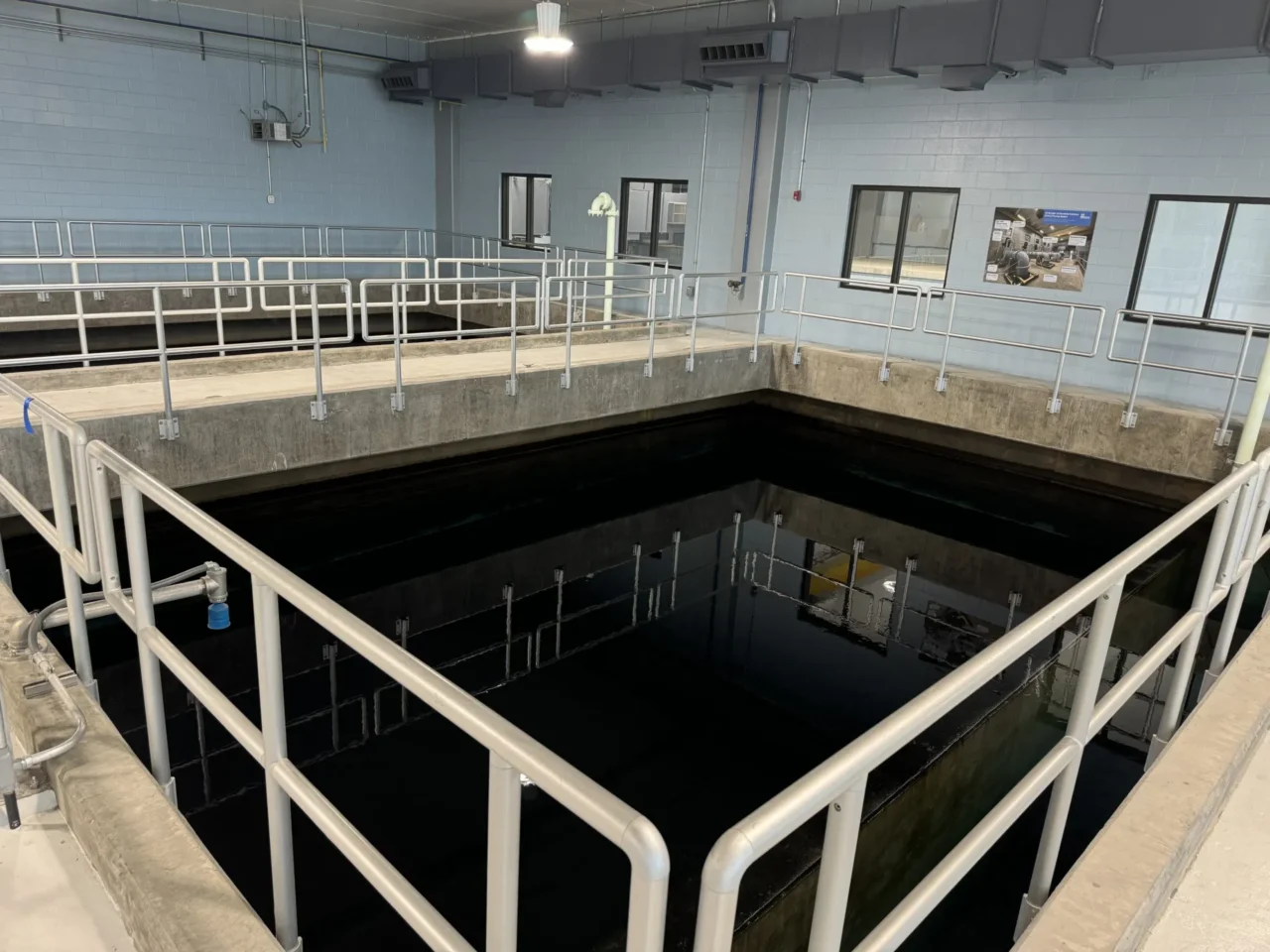
Reprinted from our longtime collaborator, North Carolina Health News, to complement our ongoing series on federal budget and staff cuts and the dismantling of programs and services affecting life and lives here on the North Carolina coast.
People who have been struggling to clean up decades of industrial pollution in the lower Cape Fear River basin are expressing their dismay and anger at a federal delay announced Wednesday on a crackdown on so-called forever chemicals that have fouled their drinking water.
Supporter Spotlight
That day, the Environmental Protection Agency announced plans to extend the timeline for water utilities to reduce the maximum safe levels for human consumption for a select group of per- and polyfluoroalkyl substances known as PFAS.
In 2024, under the Biden Administration, the EPA finalized the first-ever enforceable standards for six PFAS compounds: PFOA, PFOS, HFPO-DA (GenX), PFBS, PFNA and PFHxS. At that time, water utilities had until 2029 to comply with the new standards.
A year later, the Trump Administration’s newly appointed EPA Administrator Lee Zeldin announced that the agency would uphold standards set for PFOA and PFOS — legacy PFAS that persist in the environment despite no longer being manufactured. But Zeldin also announced he would rescind and re-evaluate rules for the other four, including GenX.
GenX is the common name for the substance produced at the Chemours Fayetteville Works plant; it was discharged into the river’s water for decades until researchers revealed their presence in 2017.
Additionally, the new federal timeline gives utilities until 2031 to comply with the standards, extending the original 2029 deadline.
Supporter Spotlight
“We are on a path to uphold the agency’s nationwide standards to protect Americans from PFOA and PFOS in their water,” Zeldin said in a news release. “At the same time, we will work to provide common-sense flexibility in the form of additional time for compliance.”
While Zeldin’s statement appeared aimed at reassuring the public that the EPA is taking control of the situation, to critics, it sounded like a betrayal — signaling, in their view, a retreat from more robust protections from substances that have become known as “forever chemicals” because of their persistence in the environment.
‘Not forward-thinking’
“Overall, PFOA and PFOS are chemicals of the past, though they are still present in drinking water sources. So removing them will get a lot of others,” said N.C. State University epidemiologist Jane Hoppin in an email. “But the other four are chemicals of the future, particularly GenX, so removing these rules would not be forward-looking.”
In 2017, Hoppin headed a team of researchers and launched the GenX Exposure Study, which revealed that most of the people from the Cape Fear River Basin who participated in the research have PFAS in their blood.
There are thousands of unique PFAS in the environment, according to experts. They’re present in multiple products to help make them slippery and resistant to oils, water and solvents, including some cosmetics and apparel, microwave popcorn wrappers, dental floss, firefighting gear and some firefighting foams.
PFAS exposure is associated with a range of adverse health effects, such as increased cholesterol levels, kidney and testicular cancer, pre-eclampsia in pregnant women and decreased vaccine response in children, among other conditions.
“The EPA is caving to chemical industry lobbyists and pressure by the water utilities, and in doing so, it’s sentencing millions of Americans to drink contaminated water for years to come,” said Environmental Working Group President Ken Cook in a statement.
Cook’s organization has worked throughout the country to document environmental problems.
“The cost of PFAS pollution will fall on ordinary people, who will pay in the form of polluted water and more sickness, more suffering and more deaths from PFAS-related diseases,” he said.
Kelly Moser, senior attorney and leader of the Water Program at the Southern Environmental Law Center, echoed this sentiment. “When this administration talks about deregulation, this is what they mean — allowing toxic chemicals in drinking water at the request of polluters,” she said in a release.
Living with PFAS
It has been a tumultuous eight years for thousands of North Carolinians living in the Cape Fear River Basin since the presence of the forever chemicals was first announced in 2017. Among those affected are residents whose drinking water wells are contaminated, likely because of PFAS that were incinerated at the Fayetteville Works plant and drifted far and wide in emissions from the factory.
Despite a 2019 consent order — established among Chemours, Cape Fear River Watch and the North Carolina Department of Environmental Quality — aimed at assisting residents with PFAS-contaminated wells, living with PFAS is a daunting challenge.
Jamie White, administrator of the Facebook group “Grays Creek Residents United Against PFAS in our Wells and Rivers,” which works to raise awareness about PFAS contamination, expressed the group’s frustration after the EPA’s latest announcement.
“Well, it shocked us all, first off — and when I say all I speak for the group,” White said during a call with NC Health News. “Number one, we have worked for eight years to get the limits lowered, to bring awareness to everybody, because our wells are contaminated.”
“(The EPA) extended the public water facilities another two years (before) having to have the chemicals cleaned out of their water systems — another two years of contaminating the public,” she said.
Jane Jacobs (EagleHeart), a tribal leader of the Tuscarora Nation, an Indigenous community with many members in the Cape Fear River Basin, criticized the lack of action to protect vulnerable communities.
“My children, my grandchildren, need to be protected from all of the poison, not some of the poison,” Jacobs said. “If somebody was pointing a gun at my kid right now, am I going to protect him from one bullet or all of the bullets?”
Jacobs also highlighted the disproportionate impact on her community.
“Being a bipoc community, we face a lot more environmental hardships than most people do,” she stated. “We have to drink the tap water. We don’t have money for filters, so for the people in my community, this affects us 10 times worse because we don’t have the money to protect ourselves.”
Looking ahead
While many expressed disappointment over the EPA’s decision, the environmental community remains hopeful that more stringent rules could eventually prevail at the state level — though it may take time.
One significant obstacle is the Environmental Management Commission, which is responsible for developing regulations to safeguard, preserve and improve the state’s air and water resources. Since 2022, the North Carolina Department of Environmental Quality has been working with the commission to establish regulations for PFAS and 1,4 dioxane — a cancer-causing pollutant that’s also been found to be widely discharged by industrial companies and ultimately flow into the Cape Fear River.
However, a series of delays have stalled progress, preventing the process from advancing to the public comment period — the next step toward establishing maximum contaminant levels for PFAS at the state level.
The most recent Environmental Management Commission meeting, on May 7, ended in another delay after the Office of State Budget and Management raised concerns about the proposal’s fiscal analysis.
Possible remedies
Despite the setbacks, several people at the meeting expressed relief, including Haw Riverkeeper Emily Sutton.
“There’s not actually any checks or enforcement to make sure that the plans that are drafted are effective, and so this (plan) doesn’t do anything for our downstream community members,” Sutton said.
She also criticized the fiscal analysis requested by the Office of State Budget and Management.
“The fiscal analysis that they’ve asked for also is flawed. It doesn’t include information about the financial impacts for downstream communities who are bearing the burden of this pollution. (The fiscal analysis) is looking at how much this is going to cost polluting industries. That’s not our concern. Our concern is the health of our community members.”
Southern Environmental Law Center’s Moser agrees that the commission’s proposal falls short of the outcome environmental groups demand.
“The EMC is siding with polluters and considering adopting rules that were written by polluters,” Moser said. “That could allow industrial facilities to release PFAs indefinitely into North Carolina’s drinking water sources and even increase the toxic water pollution that they are putting into our waterways.”
Sutton and Moser and their colleagues are closely monitoring Senate Bill S666 — the Water Safety Act — proposed by North Carolina Senate Majority Leader Michael Lee, R-New Hanover. If passed, the bill would deliver the state-level regulatory action environmentalists are pushing for.
“ (The proposed bill) directs the EMC to set regulatory limits on PFAs, and that is what our hope is,” Sutton said. “We don’t trust that this commission will hold polluters accountable, and unfortunately, the Department of Environmental Quality has to abide by what they are directed by the EMC.”
Moser pointed out that a potential remedy exists to address the water pollution problem: “It’s more important than ever that states like North Carolina, EPA and wastewater treatment plants use their current authority under the Clean Water Act to require that industry stops their pollution at the source before discharging it into our waterways.”
The Environmental Management Commission is scheduled to meet again in July, while the EPA is expected to update federal PFAS standards by late 2025, with finalization anticipated by spring 2026. Amid these ongoing challenges, Jacobs offered a rallying cry to fellow environmentalists: “We just need to keep pushing. We need to keep fighting.”







